
Jordan Baseman. Still from A Different Kind of Different. ‘My mum and I went through menopause together….we were like a fucked-up scary double act’. Courtesy of the artist and Matt's Gallery, London.
by VERONICA SIMPSON
Jordan Baseman (b1960, US) is a visual artist and film-maker who likes to take his audiences into areas where most would fear to tread. The first show of his that I encountered, at the Fabrica Gallery in Brighton, in 2013, was about death and those who care for the dead. The main attraction was Fabrica’s newly commissioned film, A Cold Hand on a Cold Day, featuring an interview with Cara Mair, a female undertaker who is exploring holistic funerary practices. Her gentle, conversational monologue was accompanied by grainy time-lapsed footage of dark skies, on 16mm film, hand-processed via the most rudimentary procedures, so that the shifting cloudscapes are strewn with scratches, stains and scuffs. The work was touching, poetic and weirdly uplifting.
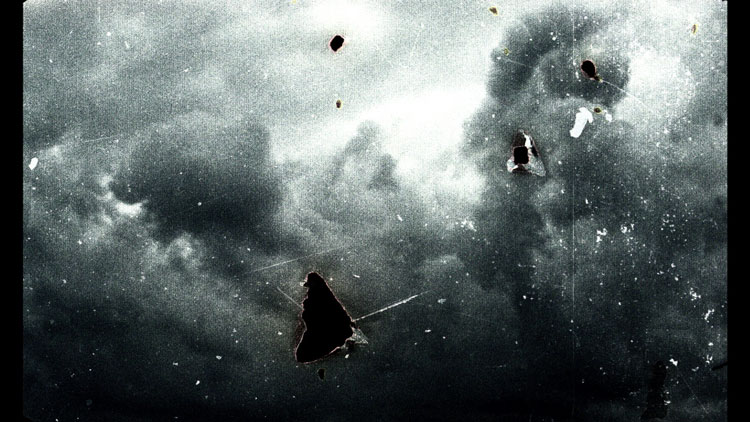
Jordan Baseman. Still from A Cold Hand On a Cold Day, 2013. Commissioned for the exhibition of the same name at Brighton's Fabrica gallery, 2013.
Baseman’s latest work has taken him in a different direction, technically and topically. A Different Kind of Different (2020) is an animated cartoon that provides a fascinating portal to the experience of breast cancer treatment, and the emerging practice of mastectomy tattoos. It was the result of many hours of interviews that Baseman conducted with breast cancer survivors in 2019, exploring their views about the changes to their bodies during and after treatment, and their shifting attitudes to beauty, femininity and identity.
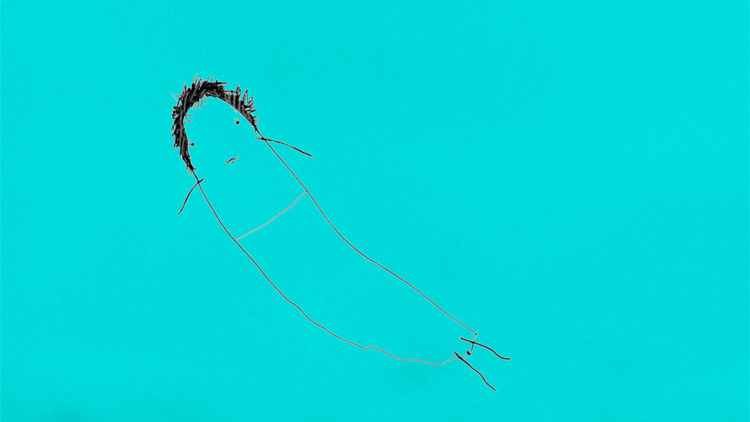
Jordan Baseman. Still from A Different Kind of Different. ‘Breast cancer takes a lot out of you’. Courtesy of the artist and Matt's Gallery, London.
The production of the film was a complex collaborative process: Baseman worked closely with a team of animators, and actors voiced most of the parts, using a script developed by Baseman with the writer Sally O’Reilly based on verbatim accounts; the soundtrack was composed by Die Hexen.
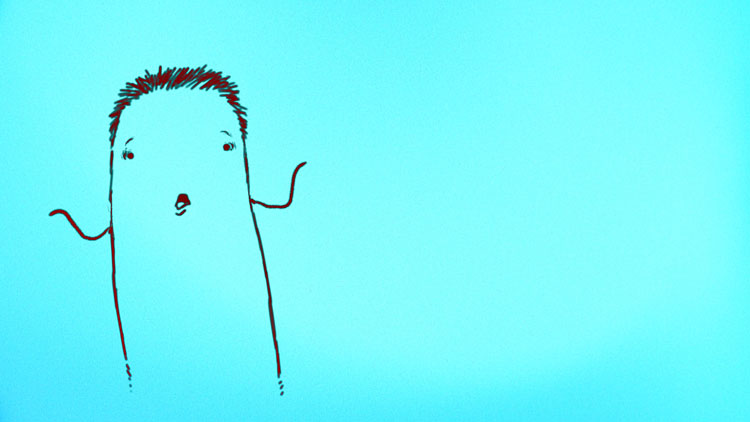
Jordan Baseman. Still from A Different Kind of Different. ‘They see no boobs, they think “it’s a guy”.’ Courtesy of the artist and Matt's Gallery, London.
The film was co-produced by Matt’s Gallery, London, which represents Baseman, and Nerve Centre, Derry. Funded by an award from the Wellcome Trust, with additional support from Matt’s Gallery, the RCA, Nerve Centre and the Arts Council England, it will be screened throughout this month at online participatory events, to draw out discussion on the topics covered, and will tour the UK throughout the year.
Baseman has an MA in fine art from Goldsmiths, University of London, and a BFA from the Tyler School of Art, Philadelphia. He has exhibited internationally in solo and group shows and film festivals, including at the 53rd Venice Biennale. He is based in London and is a reader in time-based media and a senior tutor and pathway leader in moving image at the Royal College of Art.
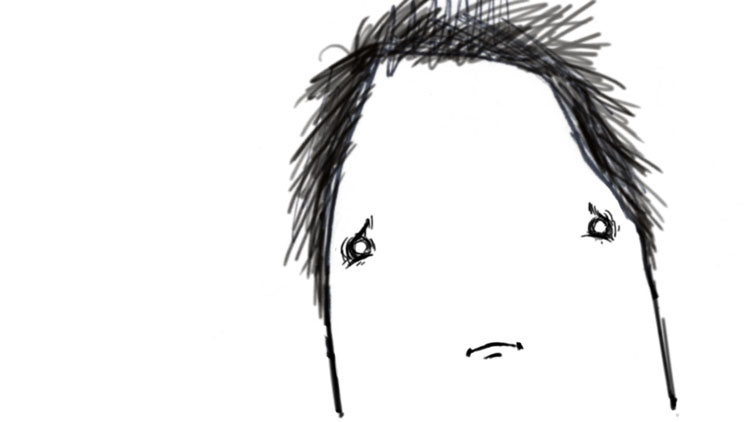
Jordan Baseman. Still from A Different Kind of Different. ‘I just kind of pushed it to the back of my mind’. Courtesy of the artist and Matt's Gallery, London.
You can view A Different Kind of Different here, and find out about screenings and events.
Veronica Simpson: In your work, you are willing to take us to very dark places. But while your themes are usually universal – death, end-of-life experiences, heart surgery – this one was very specific. How did you become interested in the topic of mastectomy tattoos?
Jordan Baseman: I read an article in a newspaper in 2013, about mastectomy tattoos, but it focused on two things: one, that it wasn’t really happening in the UK and, two, that Facebook had censored an image of a woman, Inga Duncan Thornell, which a friend of hers had posted on Facebook, saying, “Look at my beautiful friend.” Facebook had censored it because she was topless, even though she didn’t have breasts. [The tattoo, done after a double mastectomy, appears like clothing.] What interested me was … there’s this expectation about what you’re meant to do, how you’re meant to behave and who you’re meant to be and people are saying: “That’s not who I am and you’re not going to define me in that way.” That’s what the film is about. Inga features in the film, and the line: “I’m a work in progress.” I would like to think we’re always in a state of development, always learning and questioning and challenging perceived wisdoms. That’s what really struck me about that article.
I didn’t do anything with it at the time, but it was in the back of my mind. I wrote to Inga, but she didn’t write back. I found a book called Bodies of Subversion: A Secret History of Women and Tattoo, by Margot Mifflin. It’s the first western history of women’s tattooing, published in 1997. Margot is the first person to write about these tattoos academically. I wrote to Margot and we developed a conversation. Margot introduced me to tattooists and they introduced me to their clients. That’s how I got to meet Inga. She’s the first person I interviewed.
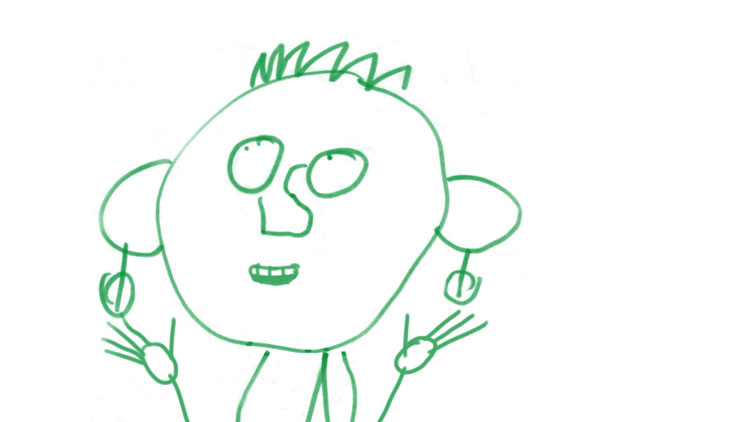
Jordan Baseman. Still from A Different Kind of Different. ‘Who cares about symmetry? Asymmetry is more natural anyway’. Courtesy of the artist and Matt's Gallery, London.
VS: Were you planning to make a film when you conducted these interviews?
JB: I started writing to people, having conversations not really knowing what I was doing. I applied for a small research and development grant from the Wellcome Trust that allowed me to go to the US and interview people, interview Margot, some tattooists, a bunch of people with mastectomy tattoos and some academics here. About halfway through my research, I realised it felt as if animation or a cartoon was the most obvious or natural thing to be doing. I knew I didn’t want to use the interviews I had filmed. I didn’t want it to be a documentary. I didn’t want it to be that literal.
VS: It is interesting to hear these stories via an animation. It makes you listen in a very different way.
JB: This was a very different film almost a year ago. It was twice as long and had a lot more information, but it didn’t work. The animation wasn’t doing what I really needed it to do. I did a radical re-edit, and made it much more open and less visual. I started to take things away. I wanted the composer to have more space. But I didn’t realise that by creating more openness and fewer visuals, it enabled people to take a bit of a breather, it enabled people to imagine more.
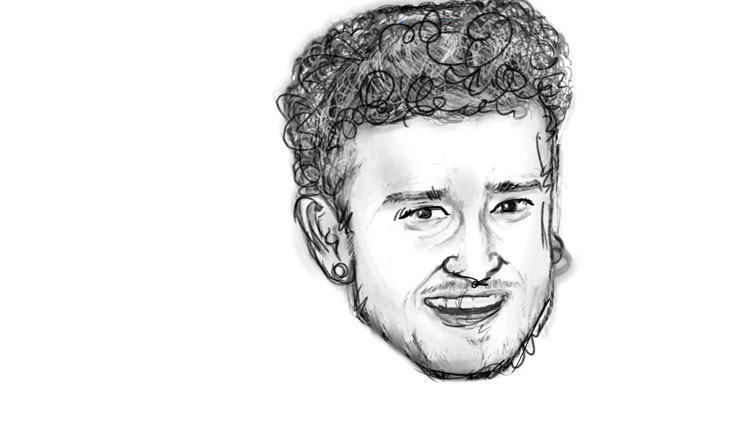
Jordan Baseman. Still from A Different Kind of Different. ‘I looked like Justin Fucking
Timberlake!’ Courtesy of the artist and Matt's Gallery, London.
VS: The animation allows you to bring out some of the humour in these women’s accounts, but without losing any of the empathy and compassion. For example, the moment when the main character, Alicia, talks about her hair coming back curly post-chemotherapy, and not wanting to look like Justin Timberlake, the animation can convey how funny that line is (she transforms into a cartoon Timberlake) without seeming inappropriate or tactless.
JB: The thing is that 90% of the dialogue is taken verbatim from the interviews. It was really important to stay true to the language. It’s a synthesis of 11 people with mastectomy tattoos, of their experience. I did interview someone named Alicia and asked if I could name the main character after her. The film is probably 50% Alicia – and she did talk about Justin Timberlake. I wanted to be respectful to her and everyone else and their experience and not denigrate it, but also to be aware of what was gifted to me. And that’s how it feels: I was given these gifts, though they were challenging gifts, and in order to treat them with the dignity and respect that I needed to, it seemed a cartoon or animation was the only way to talk about the extremities of the experiences that they were reporting to me.
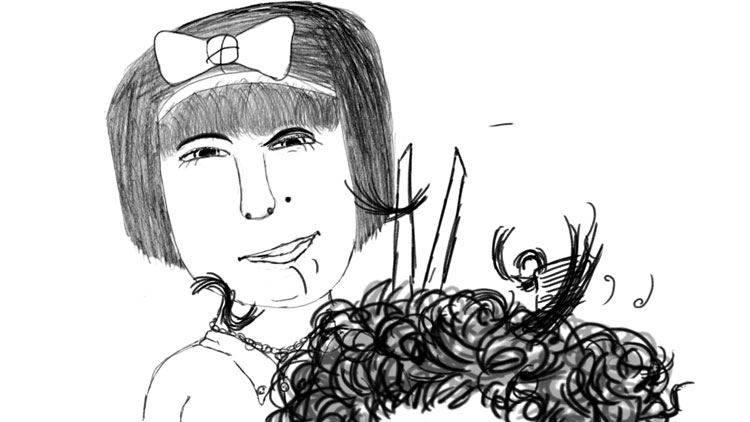
Jordan Baseman. Still from A Different Kind of Different. ‘I was more determined to get rid of these stupid curls than anything else’. Courtesy of the artist and Matt's Gallery, London.
That sounds stupid, but it was so amazingly extreme what these people had been through, and the way they had reordered their lives and pulled things back together in the way they wanted to, so they could continue to feel like themselves, it was such a huge thing. I felt the weight of their experiences pressing on me all the way through. It took me so long to tell them it was going to be an animation. Even though I was always up front, and said I don’t know what I’m making, but then to say I’m turning this traumatic stuff that’s happened to you into an animation could have been really bad.
VS: How did they respond when you showed them the film?
JB: They loved it. As I was making the film, people (not the interviewees) had questioned the fact that I’m a man. What the hell do I know about having breasts? In order for that awkwardness and difficulty of me having no clue, in order to make the project as open as possible, I consulted (the interviewees) every step of the way, I gave them all the raw material, the edits. I was as transparent as possible. And the response has been really positive, even though the (text) is quite angry and sweary at times.
VS: It is going to be so interesting to see how people respond to the film, as a provocation, in the discussions that are scheduled.
JB: Yeah, provocation is the right word. We were going to put it physically in the world in April 2020. But the world had other plans. Then it got to the point where we didn’t know how to put it out there. This was in March 2020. I started to think we would have to put it out online, but I didn’t want to do it in an unchallenging way. So, we started to think about how we could have a few events, make each one distinctive, allow people to respond critically to the work. We would have done something similar in real life, but it would have been more conventional in terms of what we’re asking of people, but also how they could respond.
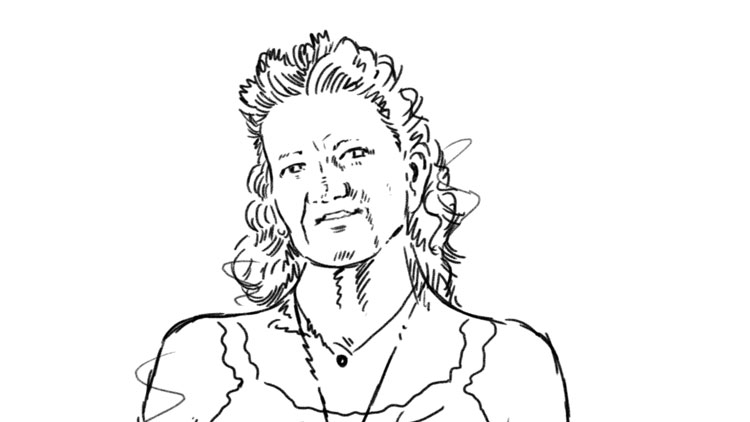
Jordan Baseman. Still from A Different Kind of Different. ‘I couldn’t face any more invasive surgery, so I decided to go flat…..Holy Mother of God, this is a declaration of intent’. Courtesy of the artist and Matt's Gallery, London.
This was an opportunity to think differently about the project, to reach audiences we wouldn’t have otherwise been able to reach - to invite people who’ve had similar and relevant experiences, or who have worked with people who have had these traumas. Let’s invite artists, let’s invite writers, and let’s just see. I want to hear what they say and how they engage with it.
We’re doing these viewings and also screenings with cancer groups and doctors. There’s a companion programme running alongside it. We did an event the other day, it was the first public screening of the work and we showed it to cancer survivors. That was really successful. However, I had shown it in a PhD session two days before, along with a 45-minute talk, and people had got really hung up on the children’s drawings (some of the animated characters appear as children’s drawings), and I was asked why I was infantilising women’s bodies. But two days later, at the cancer survivors’ group, everyone was saying how positive it was that they were animations because it enabled them to project themselves into the drawings, it also stopped them from having to worry or think about representation or what people looked like or were like and size and weight and colour. All of that was not relevant to their experience of witnessing these cartoon characters. I was hoping that these drawings would be really open and allow these readings. The reason I chose to use children’s drawings is because everyone I spoke to reported how out of control they felt and how childlike and unempowered and angry, and how their emotions were out of control, similar to how you felt as a child when things didn’t go your way.
VS: I liked that. It also resonated with the fact that, as children, we take on board a strong imprint of how we are supposed to look or be as boys or girls. I thought it was right that you were evoking that elemental understanding, this stick-figure notion of how we should present ourselves, and playing with it.
JB: I didn’t draw them, I art-directed it, I modified the drawings. I made those decisions. But I wanted it to be so simple. This was challenging for the animators.
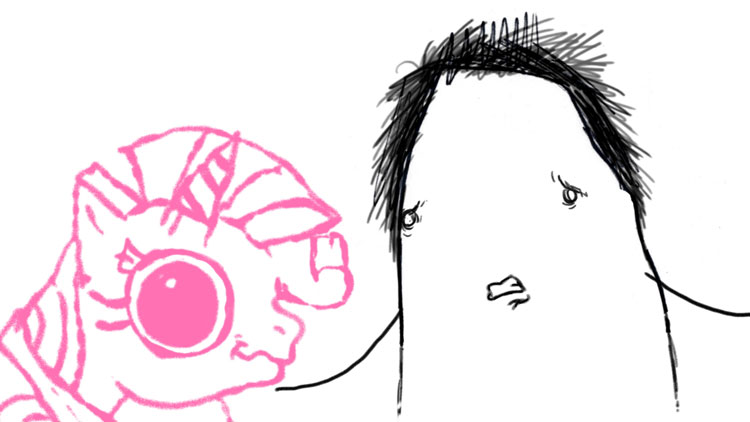
Jordan Baseman. Still from A Different Kind of Different. ‘Flat? Is that a thing?’. Courtesy of the artist and Matt's Gallery, London.
VS: Is this the first time you have worked in such a collaborative way, and not had a hands-on role in every aspect?
JB: I’ve never done anything close to this in any way, shape or form. I’ve never written something with anybody, used real interviews to write a script, never worked with a team of people, with a composer, a sound person, with actors. I never did any of this stuff before. In fact, it wasn’t until the end of December 2019, when I got all the raw material and that’s when it began to feel like my project - four years into it. When all the animation was done, the soundtrack, the dialogue had been recorded. And when I began to edit it and change it and put it together, it began to feel like something I’d made.
But I’ve really enjoyed working like this, I’ve learned so much. And honestly the best thing was meeting the people I interviewed: to spend time with them, to listen to them, to be able to bear witness to their experiences. I wanted to keep that feeling in the film. I felt this sense of awe when I spoke to people. You do feel that sense of awe in the character of Alicia. She’s so strong, she’s not taking any shit, but she’s also so vulnerable and also open to change. I don’t meet many people that are like that these days, so it was really important to me to keep that spirit in the finished work.
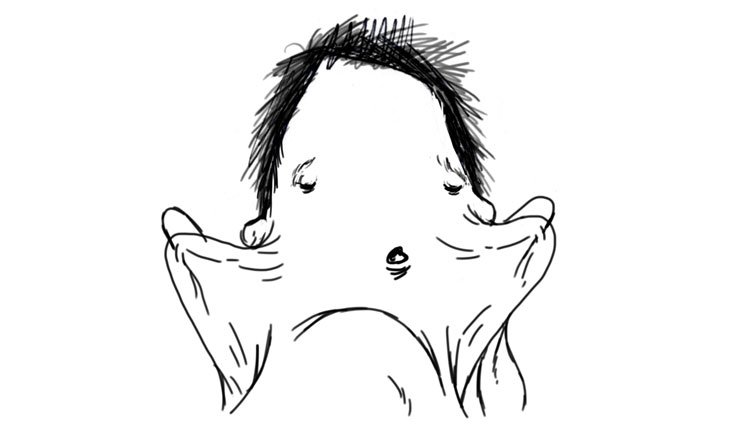
Jordan Baseman. Still from A Different Kind of Different. ‘I certainy have plenty of it, why not make a feature of it?’ Courtesy of the artist and Matt's Gallery, London.
VS: All your work that I have encountered has this courage and compassion in confronting difficult topics. Is that something that drives you?
JB: I would love to say yes to that – it makes it sound like I know what I’m doing. I have no clue. For myself, as someone trying to make stuff, I want to be challenged. I want the work to be impactful, to carry some emotional weight. I want people to feel like they’ve been through something. I don’t want it to be dull. Now, more than ever, we’re surrounded by things on screens and moving images. There’s so much in the world. We can’t compete with all that stuff. And all the art stuff, too. It’s impossible to compete with. I don’t even try. I’ve got a couple of rules. This cartoon kind of follows that a bit. I want a narrator to sound like they’re directly addressing you, almost on a one-to-one basis. I also want the audience not to have any preamble to the work. I want you to be able to experience the work and have the work engage you, but also wash over you and through and around you. You don’t need to know anything before you see or hear the work. I also want it to be challenging for me to make, but also challenging to experience. I also want it to be structurally or visually very different, even if the method is similar.
The editing is so crucial, but it’s also hidden, it’s invisible. I want the narrator to sound as if they are speaking naturally, but they’re not. Those recordings might be months apart in different locations. I want it to sound like it was spoken in real time over that period of time.
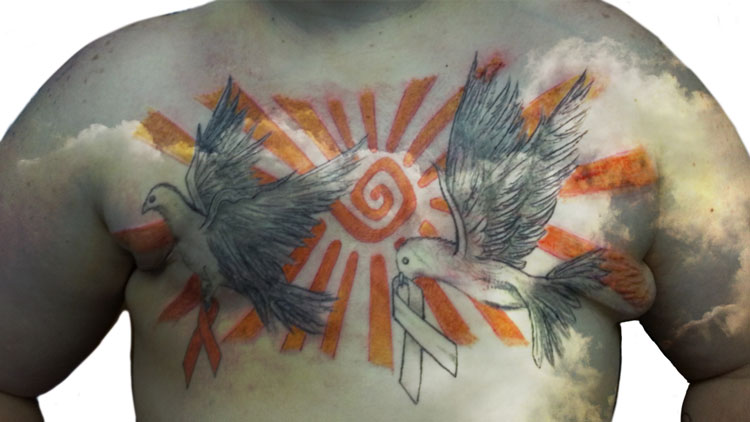
Jordan Baseman. Still from A Different Kind of Different. ‘I want birds….and ribbons….and a sun’. Courtesy of the artist and Matt's Gallery, London.
VS: That stripping away process is so important.
JB: The first thing I do is remove myself, remove my voice and any direct allusion to a question. I remove all the hesitancies, the ums and ahs. I want to have the least amount of information speak the most. To not have that much being said, but what’s said is essential to the work and the understanding of the work.
VS: Where does that impulse to strip back and reveal, without judgment, come from? It feels like quite a Buddhist approach. Is that an inspiration?
JB: Not really. My family was very religious. They are Jewish. I don’t believe in that myself but, culturally, I am definitely pretty Jewish in how I am as a person. My parents were really strict and I was out of control and misbehaved at every opportunity, so I was always in trouble. But later in life I realised how much that orchestrated religion impacted on me. It gives people a sense of order, a sense of place and continuity. I totally understand that, and I’m not critical of that, but it’s not for me at all. And what that has instilled in me is a curiosity about how we live our lives and how we order our lives and what we do that’s important to us.
VS: What comes across in your interviews is a real ability to listen, without preconceptions.
JB: When someone tells me something, I never question whether it’s true or not. Whatever they tell me, it’s something that’s true for them. I want them to talk. But I also genuinely don’t judge them. I mean, my parents were so judgmental. And so harsh in their judgment. And I never understood that.
VS: Could this early experience have drawn you to the exploration of taboos?
JB: I don’t know about taboo, so much. What interests me is people who have chosen to do something different from others around them. I think I’m interested in people who don’t follow. The idea of taboo – that is other people’s judgment of the behaviour or activity. I am not seeking out those things at all.
• Further information on events and screenings is available at https://kindofdifferent.org.